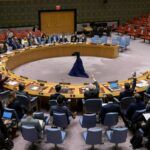The U.S.-India nuclear deal–one year later
By J. Sri Raman | October 1, 2009
October 8 marks the one-year anniversary of former President George W. Bush signing into law the so-called U.S.-India nuclear deal. The deal proved controversial from its inception because it ended a 34-year U.S. ban on nuclear trade with India, a non-signatory to the Nuclear Non-Proliferation Treaty (NPT). And yet despite heavy criticism of the deal–especially from arms control and disarmament advocates–one year later, it appears solidly entrenched as long-term policy.
As Secretary of State Hillary Clinton told the U.S.-India Business Council’s Synergies Summit in June, “The first stage of Indo-U.S. relations was ushered in when President Bill Clinton opened a new chapter of engagement with India. Then President George [W.] Bush took it to the second level with the Indo-U.S. civilian nuclear agreement. The Obama administration is determined to take it to the third stage, which would allow the countries to move beyond concerns about the status of India’s nuclear program to a framework of economic and technical cooperation.”
At its heart, the U.S.-India deal is really about big business, which has boomed since the agreement entered into force. In fact, intensive lobbying by corporate sectors in both the United States and India helped overrule the concerns of the arms control community. For Ron Somers, the president of the U.S.-India Business Council, the calculus was simple: “[The U.S.-India nuclear deal] will present a major opportunity for U.S. and Indian companies,” he promised in July 2007. He added that the deal would create up to 27,000 “high-quality” jobs per year over the next decade in the U.S. nuclear industry. And so, Somers and U.S. and Indian corporations took to Capitol Hill and sold the deal hard. According to the Washington Times, New Delhi spent about $1.3 million on two lobbying firms, one of which, Barbour, Griffith, and Rogers, was headed by former U.S. Ambassador to India Robert Blackwill until July. Meanwhile, the Confederation of Indian Industries funded numerous trips to India for U.S. congressional delegations. Modest estimates placed the total cost at about $550,000.
Those investments have already paid off. Reportedly, the Indian government recently told Washington that it was ready to buy $150 billion worth of U.S. nuclear reactors, equipment, and materials. (See “India Says Lift Ban on Dual-Use Items; Dangles $270 Billion Business”.) Indian Prime Minister Manmohan Singh’s Special Envoy Shyam Saran also has promised that U.S. companies would “benefit for decades” from Indian orders for military hardware orders, ranging from fighter jets and aircraft carriers to anti-nuclear missile shields. As with the run-up to the deal’s approval, any criticism of these transactions is being overwhelmed by the sheer magnitude of the money involved. For example, almost no one of any influence is paying attention to Indian academic and activist Dhirendra Sharma who has questioned how such long-term, large deals can be made “without clearance from the Reserve Bank of India and without engineering and technical assessment of old American reactors.”
Thus, business proceeds apace. The Deccan Chronicle reported in June that Kaiga in the southern state of Karnataka, already the site of four indigenous nuclear reactors, was being “pushed hard” as the location for the new U.S.-built reactors. The current Kaiga plants include two that are outside the purview of International Atomic Energy Agency safeguards, and thus, they are officially set aside for “strategic” or military use. Six months earlier in January, the Mumbai-based Indian conglomerate Larsen & Toubro (L&T) and the U.S.-based Westinghouse Electric Company signed a memorandum of understanding for “cooperation to effectively address the projected need in India for pressurized water nuclear reactors with modular construction technology.” The memorandum of understanding also envisions “turnkey construction of nuclear power plants including supply of reactor equipment and systems, valves, electrical and instrumentation products, and fabrication of structural, piping, and equipment modules for the Westinghouse AP1000 plants.”
Similarly, in late May, L&T and U.S.-based GE Hitachi Nuclear Energy signed a memorandum of understanding for cooperation on boiling water reactors and advanced boiling water reactors. Under the agreement, GE Hitachi and L&T will plan for the construction and engineering management resources needed to build an advanced boiling water reactor power station, and GE Hitachi will serve as the technology provider for certain equipment and components. Two months prior, GE Hitachi announced an advanced boiling water reactor development agreement with the Nuclear Power Corporation of India, the country’s only nuclear utility and operator of 17 domestic reactors. More largely, GE Hitachi says it is building its local supply chain in India and is exploring new business opportunities for civilian Indian nuclear power, including plant services and providing fuel for existing and new plants.
Non-U.S. companies also are getting in on the action. (As part of the U.S.-India nuclear deal, the Nuclear Suppliers Group, or NSG, waived its standard conditions to do business with India, which had not met its nonproliferation guidelines previously, giving the bilateral deal a multilateral character.) For instance, in April, a Swedish business delegation on nuclear technology and safety management arrived in India. Its mission–to understand the Indian nuclear energy market and explore business opportunities. That same month, L&T and Russia-based Atomstroyexport signed a memorandum of understanding to cooperate on Russian-designed VVER reactors. Atomstroyexport is part of the government-controlled corporation Rosatom and implements intergovernmental agreements on constructing nuclear facilities abroad. It accounts for more than 20 percent of the world market volume of nuclear power equipment and services–including participation in the construction, as well as management, of nuclear plants. It is the only company performing contracts in four countries simultaneously–China, India, Iran, and Bulgaria. In short, Atomstroyexport can be expected to offer stiff competition to U.S. companies doing business in India.
And then, of course, there’s industry leader Areva. In January, Bharat Forge Limited, a large Indian manufacturer of automotive forgings, signed an agreement with the French firm to build a manufacturing facility for heavy forgings in India by 2012. Bharat Forge is the $2.4-billion flagship firm of the Kalyani Group, a leading Indian industrial company. Bharat Forge has manufacturing units in five foreign countries–the United States, China, Germany, Sweden, and Britain. So far, Paris seems impressed with the partnership: It chose Singh as the chief guest at its National Day Parade, a very public sign that it would like to keep its nuclear commerce with New Delhi going.
A lot of India’s nuclear trade will hinge on uranium imports due to its poor domestic resources. Here, the concerns of anti-nuclear weapon activists are particularly acute. They argue that if India is allowed to import a large amount of uranium, it will free up more domestic uranium for the country’s military program. Some in the Indian government basically have admitted as much. “Given India’s uranium ore crunch, it is to India’s advantage to categorize as many power reactors as possible as civilian ones to be refueled by imported uranium and conserve our native uranium fuel for weapon-grade plutonium production,” the former head of New Delhi’s official National Security Advisory Board, K. Subrahmanyam, wrote in the Times of India.
Three years ago, Moscow ruled out providing enriched uranium to India for its Tarapur nuclear power plant, citing NSG rules. But after former Russian President Vladimir Putin visited India in January 2007–and with the U.S.-India nuclear deal right around the corner–Moscow cleared the way for uranium exports to India. Likewise, Australian Prime Minister Kevin Rudd ruled out selling uranium to India when he took office in November 2007. But not long after that, Rudd surprised his supporters by announcing that he was in favor of granting India the NSG waiver.
For devout domestic supporters of the U.S.-India nuclear deal, it is mission accomplished. After all, as Times of India columnist Swaminathan Aiyar wrote in an April article, “The multinationals of France, the United States, and Japan want to manufacture nuclear equipment in India to meet not just Indian, but global demand. Once India becomes part of the global supply chain, it will become effectively sanctions-proof. As a supplier of global equipment, it will be in a position to impose sanctions on others, not just be at the receiving end.” He added, “De facto, India will become a member of the privileged [permanent five] when it becomes part of the global supply chain of nuclear equipment in the next 10 years.”
Much of this potential could dissipate, however, if New Delhi doesn’t meet certain conditions–namely, agreeing to a nuclear liability law covering its facilities. In June, U.S. Assistant Secretary of State for South and Central Asian Affairs Robert Blake told the House Foreign Affairs Committee, “We’re hoping to see action on nuclear liability legislation that would reduce liability for American companies and allow them to invest in India.”
The stated purpose of the law will be to shield U.S. and international suppliers from liability in the event of a nuclear accident and make plant operators responsible for damages from any accidents. As such, operators must set aside about $450 million for compensation in case of damage, with the signatory governments covering additional claims. Competitors to U.S. firms, such as Areva and Rosatom, are covered by sovereign immunity because they are fully or partially controlled by their governments. Former Secretary of State Condoleezza Rice and other State Department officials have repeatedly stated that they expect India to create a “level playing field” for U.S. companies. It is difficult to see the Obama administration taking a different stance.
Chances are that New Delhi will adhere to Washington’s wishes. An unnamed minister in Singh’s government recently told a reporter: “The draft of the Nuclear Liability Bill is ready. What this will do is indemnify American companies.” The move, however, will face stiff resistance from the government’s opposition and the country’s anti-nuclear movement. It remains to be seen how the government will counter this resistance.
Some analysts see the biggest hurdle to the proposed partnerships with India–whether it is Paris’s partnership, Moscow’s partnership, or Washington’s partnership–arising from a declaration that came out of the recent Group of Eight summit in Italy, which talked of curbing transfer of enrichment and reprocessing technology to countries that haven’t signed the NPT. India, however, seems unconcerned. “We have a clean waiver from the NSG,” Finance Minister Pranab Mukherjee, who served as New Delhi’s external affairs minister when the U.S.-India nuclear deal was being negotiated, told the Indian Parliament in July. “Every [NSG member] can trade with us. . . . Therefore, we are not deeply concerned.”
And until multinational corporations are convinced that there is no more money to be made collaborating with India on nuclear projects, New Delhi probably doesn’t have reason to be concerned.
Together, we make the world safer.
The Bulletin elevates expert voices above the noise. But as an independent nonprofit organization, our operations depend on the support of readers like you. Help us continue to deliver quality journalism that holds leaders accountable. Your support of our work at any level is important. In return, we promise our coverage will be understandable, influential, vigilant, solution-oriented, and fair-minded. Together we can make a difference.
Topics: Opinion















Great post..Thank you..